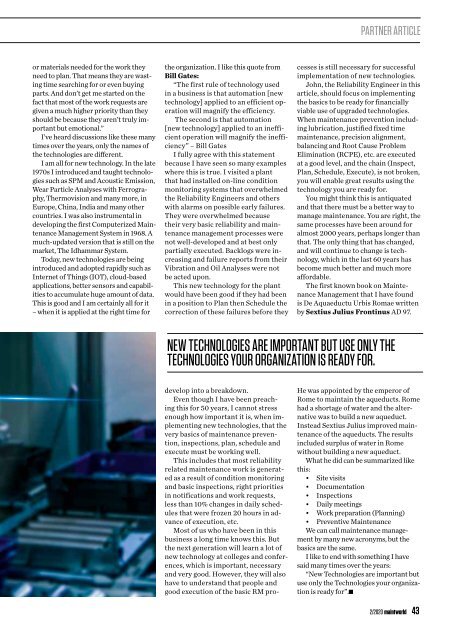Maintworld 2/2020
To the Bravest Asset Managers – Living and working in the post-corona era ADAPTIVE ALIGNMENT - DATA-DRIVEN SPARE PARTS MANAGEMENT - MANAGING THE CRISIS EFFECTIVELY
To the Bravest Asset Managers – Living and working in the post-corona era
ADAPTIVE ALIGNMENT - DATA-DRIVEN SPARE PARTS MANAGEMENT - MANAGING THE CRISIS EFFECTIVELY
Create successful ePaper yourself
Turn your PDF publications into a flip-book with our unique Google optimized e-Paper software.
PARTNER ARTICLE<br />
or materials needed for the work they<br />
need to plan. That means they are wasting<br />
time searching for or even buying<br />
parts. And don’t get me started on the<br />
fact that most of the work requests are<br />
given a much higher priority than they<br />
should be because they aren’t truly important<br />
but emotional.”<br />
I’ve heard discussions like these many<br />
times over the years, only the names of<br />
the technologies are different.<br />
I am all for new technology. In the late<br />
1970s I introduced and taught technologies<br />
such as SPM and Acoustic Emission,<br />
Wear Particle Analyses with Ferrography,<br />
Thermovision and many more, in<br />
Europe, China, India and many other<br />
countries. I was also instrumental in<br />
developing the first Computerized Maintenance<br />
Management System in 1968. A<br />
much-updated version that is still on the<br />
market, The Idhammar System.<br />
Today, new technologies are being<br />
introduced and adopted rapidly such as<br />
Internet of Things (IOT), cloud-based<br />
applications, better sensors and capabilities<br />
to accumulate huge amount of data.<br />
This is good and I am certainly all for it<br />
– when it is applied at the right time for<br />
the organization. I like this quote from<br />
Bill Gates:<br />
“The first rule of technology used<br />
in a business is that automation [new<br />
technology] applied to an efficient operation<br />
will magnify the efficiency.<br />
The second is that automation<br />
[new technology] applied to an inefficient<br />
operation will magnify the inefficiency”<br />
– Bill Gates<br />
I fully agree with this statement<br />
because I have seen so many examples<br />
where this is true. I visited a plant<br />
that had installed on-line condition<br />
monitoring systems that overwhelmed<br />
the Reliability Engineers and others<br />
with alarms on possible early failures.<br />
They were overwhelmed because<br />
their very basic reliability and maintenance<br />
management processes were<br />
not well-developed and at best only<br />
partially executed. Backlogs were increasing<br />
and failure reports from their<br />
Vibration and Oil Analyses were not<br />
be acted upon.<br />
This new technology for the plant<br />
would have been good if they had been<br />
in a position to Plan then Schedule the<br />
correction of these failures before they<br />
develop into a breakdown.<br />
Even though I have been preaching<br />
this for 50 years, I cannot stress<br />
enough how important it is, when implementing<br />
new technologies, that the<br />
very basics of maintenance prevention,<br />
inspections, plan, schedule and<br />
execute must be working well.<br />
This includes that most reliability<br />
related maintenance work is generated<br />
as a result of condition monitoring<br />
and basic inspections, right priorities<br />
in notifications and work requests,<br />
less than 10% changes in daily schedules<br />
that were frozen 20 hours in advance<br />
of execution, etc.<br />
Most of us who have been in this<br />
business a long time knows this. But<br />
the next generation will learn a lot of<br />
new technology at colleges and conferences,<br />
which is important, necessary<br />
and very good. However, they will also<br />
have to understand that people and<br />
good execution of the basic RM processes<br />
is still necessary for successful<br />
implementation of new technologies.<br />
John, the Reliability Engineer in this<br />
article, should focus on implementing<br />
the basics to be ready for financially<br />
viable use of upgraded technologies.<br />
When maintenance prevention including<br />
lubrication, justified fixed time<br />
maintenance, precision alignment,<br />
balancing and Root Cause Problem<br />
Elimination (RCPE), etc. are executed<br />
at a good level, and the chain (Inspect,<br />
Plan, Schedule, Execute), is not broken,<br />
you will enable great results using the<br />
technology you are ready for.<br />
You might think this is antiquated<br />
and that there must be a better way to<br />
manage maintenance. You are right, the<br />
same processes have been around for<br />
almost 2000 years, perhaps longer than<br />
that. The only thing that has changed,<br />
and will continue to change is technology,<br />
which in the last 60 years has<br />
become much better and much more<br />
affordable.<br />
The first known book on Maintenance<br />
Management that I have found<br />
is De Aquaeductu Urbis Romae written<br />
by Sextius Julius Frontinus AD 97.<br />
NEW TECHNOLOGIES ARE IMPORTANT BUT USE ONLY THE<br />
TECHNOLOGIES YOUR ORGANIZATION IS READY FOR.<br />
He was appointed by the emperor of<br />
Rome to maintain the aqueducts. Rome<br />
had a shortage of water and the alternative<br />
was to build a new aqueduct.<br />
Instead Sextius Julius improved maintenance<br />
of the aqueducts. The results<br />
included surplus of water in Rome<br />
without building a new aqueduct.<br />
What he did can be summarized like<br />
this:<br />
• Site visits<br />
• Documentation<br />
• Inspections<br />
• Daily meetings<br />
• Work preparation (Planning)<br />
• Preventive Maintenance<br />
We can call maintenance management<br />
by many new acronyms, but the<br />
basics are the same.<br />
I like to end with something I have<br />
said many times over the years:<br />
“New Technologies are important but<br />
use only the Technologies your organization<br />
is ready for”.<br />
2/<strong>2020</strong> maintworld 43

















